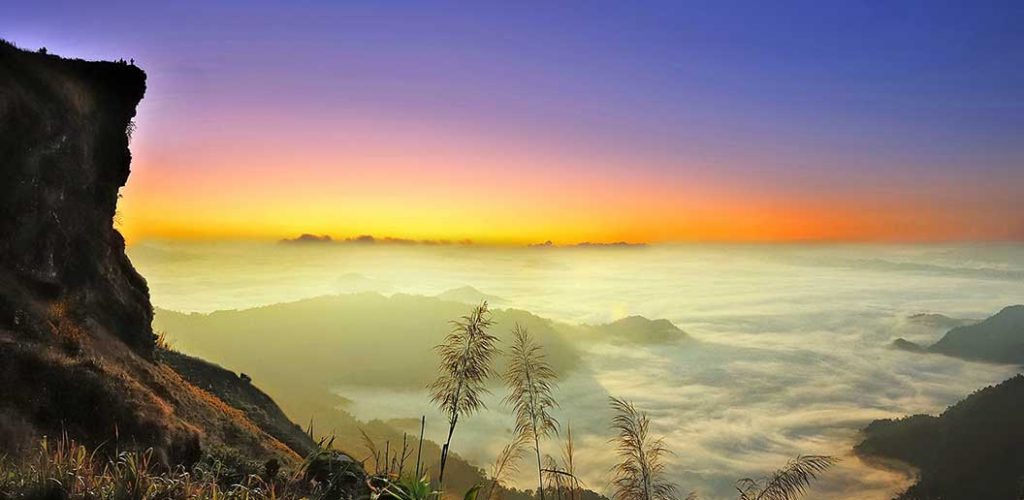In comparison to the neighboring town of Chiang Mai, Chiang Rai is far from its description as a sleepy provincial town. Close to the borders of Laos and Myanmar, the city is home to an incredible number of temples—from historic jeweled monuments to unusual contemporary artworks.
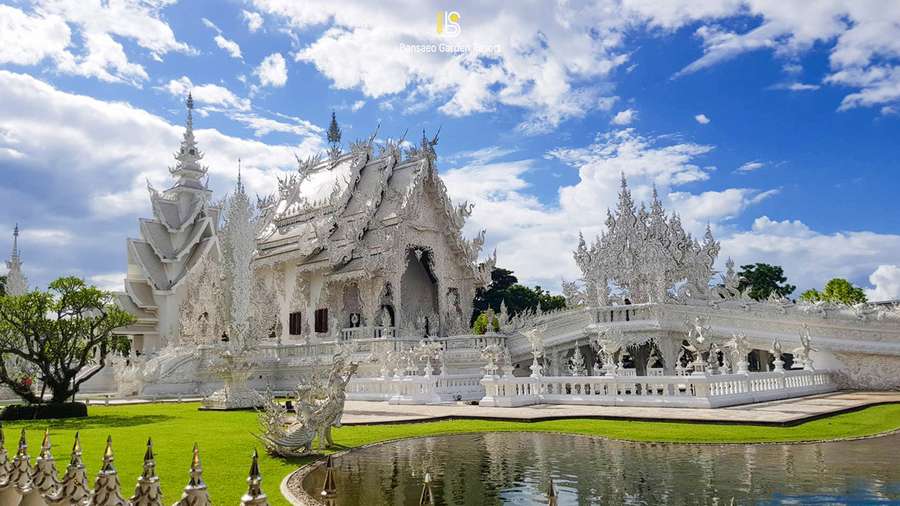 Situated in the Golden Triangle (the region bordering Myanmar and Laos), Chiang Rai was once a hub for the opium trade. Today, however, it’s famous for more benign attractions like the Black Temple and eye-popping White Temple yet it still doesn’t see the same influx of tourists that Chiang Mai does. Although a quick search of things to do in the area leaves many feeling a bit underwhelmed, there is more to Chiang Rai than meets the eye.
Situated in the Golden Triangle (the region bordering Myanmar and Laos), Chiang Rai was once a hub for the opium trade. Today, however, it’s famous for more benign attractions like the Black Temple and eye-popping White Temple yet it still doesn’t see the same influx of tourists that Chiang Mai does. Although a quick search of things to do in the area leaves many feeling a bit underwhelmed, there is more to Chiang Rai than meets the eye.
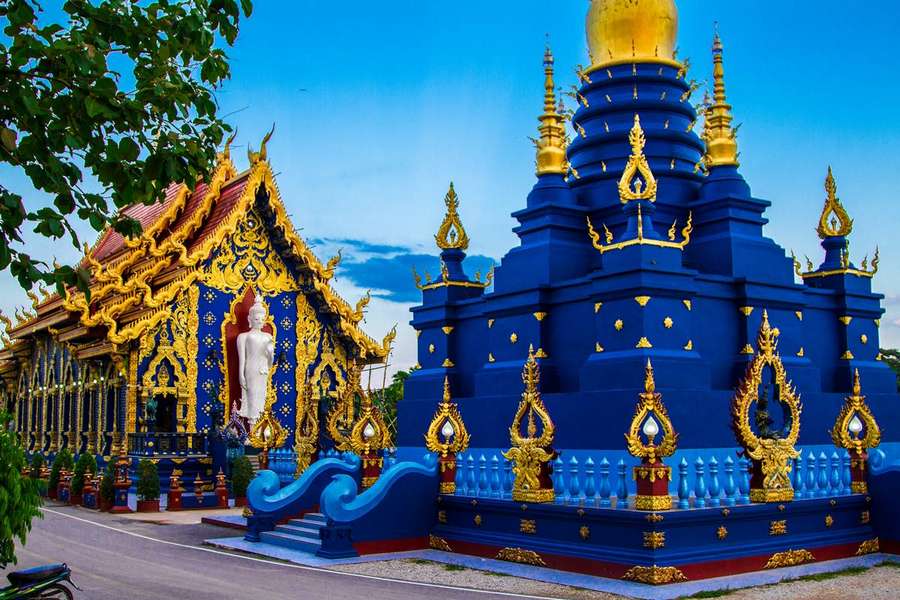 There are 1,011 temples in Chiang Rai, that’s about three times more than in Bangkok. Some of these temples date back to the early 13th Century in the time of the Lanna Kingdom, while others have been constructed only in recent years. Wat Rong Khun (the White Temple) is by far, Chiang Rai’s premier attraction. Carved with painstaking detail, the pure white, ornate facade and path leading to the entrance are deeply symbolic of desire, greed, suffering and the heavenly. It’s a religious complex unique even in Thailand. It was designed and created by local artist Chalermchai Kositpipat. Wat Rong Suea Ten translates to the house of the dancing tiger, however, it is commonly referred to by foreigners as the Blue Temple. This temple was only recently completed in 2016. Though the exterior is similar to the White Temple, the interior is painted in a bright blue color with gold detailing, and a large Buddha statue at the end of the main room making it one of the most photogenic spots in Chiang Rai. And you won’t find much information about it online because it’s a new temple but don’t forget to visit the Big Buddha, Guan Yin at Wat Huay Pla Kang.
There are 1,011 temples in Chiang Rai, that’s about three times more than in Bangkok. Some of these temples date back to the early 13th Century in the time of the Lanna Kingdom, while others have been constructed only in recent years. Wat Rong Khun (the White Temple) is by far, Chiang Rai’s premier attraction. Carved with painstaking detail, the pure white, ornate facade and path leading to the entrance are deeply symbolic of desire, greed, suffering and the heavenly. It’s a religious complex unique even in Thailand. It was designed and created by local artist Chalermchai Kositpipat. Wat Rong Suea Ten translates to the house of the dancing tiger, however, it is commonly referred to by foreigners as the Blue Temple. This temple was only recently completed in 2016. Though the exterior is similar to the White Temple, the interior is painted in a bright blue color with gold detailing, and a large Buddha statue at the end of the main room making it one of the most photogenic spots in Chiang Rai. And you won’t find much information about it online because it’s a new temple but don’t forget to visit the Big Buddha, Guan Yin at Wat Huay Pla Kang.
 Mountain trekking may be one of the most adventurous things to do in Chiang Rai. In these regions, you will also get to visit some of the authentic minority tribes such as the Karen, Akha, and Hmong ethnicities. In addition, Northern Thailand is filled with hidden waterfalls, the best being Khun Korn Waterfall. The 1400 meter walk isn’t that bad when you get to have a refreshing dip at the end. Pu Kaeng Waterfall (also spelled Phu Kaeng Waterfall) is considered to be one of the best waterfalls in Chiang Rai and all of Thailand. This waterfall consists of 9 levels flowing through the dense jungle. You will hike through the jungle for about 45 minutes from the starting point up to level 9. The trail is slippery and overgrown as not many people visit.
Mountain trekking may be one of the most adventurous things to do in Chiang Rai. In these regions, you will also get to visit some of the authentic minority tribes such as the Karen, Akha, and Hmong ethnicities. In addition, Northern Thailand is filled with hidden waterfalls, the best being Khun Korn Waterfall. The 1400 meter walk isn’t that bad when you get to have a refreshing dip at the end. Pu Kaeng Waterfall (also spelled Phu Kaeng Waterfall) is considered to be one of the best waterfalls in Chiang Rai and all of Thailand. This waterfall consists of 9 levels flowing through the dense jungle. You will hike through the jungle for about 45 minutes from the starting point up to level 9. The trail is slippery and overgrown as not many people visit.
Pu Kaeng Waterfall is a great destination to get out into wild Thailand. But if you want to stay safe, the Pong Phrabat waterfall in the Lam Nam Kok National Park consists of a couple of pools and a small cascading stream. The entrance to the waterfall is at the end of a long road veering off to the mountains behind the Rajabhat University. That area is a great picnic location. Last but not the least, don’t forget about the Huay Kaew Waterfall. It is a beautiful two-tiered waterfall, located deep in the forest. Hardly any tourists make it out this far. The road to Huay Kaew Waterfall in Chiang Rai is a steep and badly potholed dirt/concrete trail. The route follows the Kok River before heading deep into the forest. Near the end, you will pass tea plantations surrounding the Pha Soet Village and come across a sign for the waterfall. From here it is a bit of walking up the hill, but not far. Combine the Huay Kaew Waterfall, the Pha Soet Akha Village and the Huay Mak Lium Hot Spring for a great day trip from Chiang Rai.
 There’s no better way to get the lay of a city than from above. Doi In Cee is a viewpoint on the western edge of the city few make it too. The temple grounds are worth a quick look around, but the panoramic view is the main attraction here. One of the highlight of Chiang Rai would be Phu Chi Fa. As one of the province’s most scenic locations, it lies tucked away in the northeastern corner, two hours’ drive from the city itself. The jagged rocky summit of Phu Chi Fa allows you to stand way above the clouds where you can watch the sunrise. Down below in the valley is a small village along the border of Laos. Another fantastic viewpoint is Doi Pha Tang. It is located 30km north of Phu Chi Fa, near the small ethnic Chinese settlement called Ban Pha Tang. Be sure to stop by Ban Pha Tang on your way to try out the delicacy – stewed pork and steamed buns. The local restaurant offers a fantastic view of the mountains.
There’s no better way to get the lay of a city than from above. Doi In Cee is a viewpoint on the western edge of the city few make it too. The temple grounds are worth a quick look around, but the panoramic view is the main attraction here. One of the highlight of Chiang Rai would be Phu Chi Fa. As one of the province’s most scenic locations, it lies tucked away in the northeastern corner, two hours’ drive from the city itself. The jagged rocky summit of Phu Chi Fa allows you to stand way above the clouds where you can watch the sunrise. Down below in the valley is a small village along the border of Laos. Another fantastic viewpoint is Doi Pha Tang. It is located 30km north of Phu Chi Fa, near the small ethnic Chinese settlement called Ban Pha Tang. Be sure to stop by Ban Pha Tang on your way to try out the delicacy – stewed pork and steamed buns. The local restaurant offers a fantastic view of the mountains.
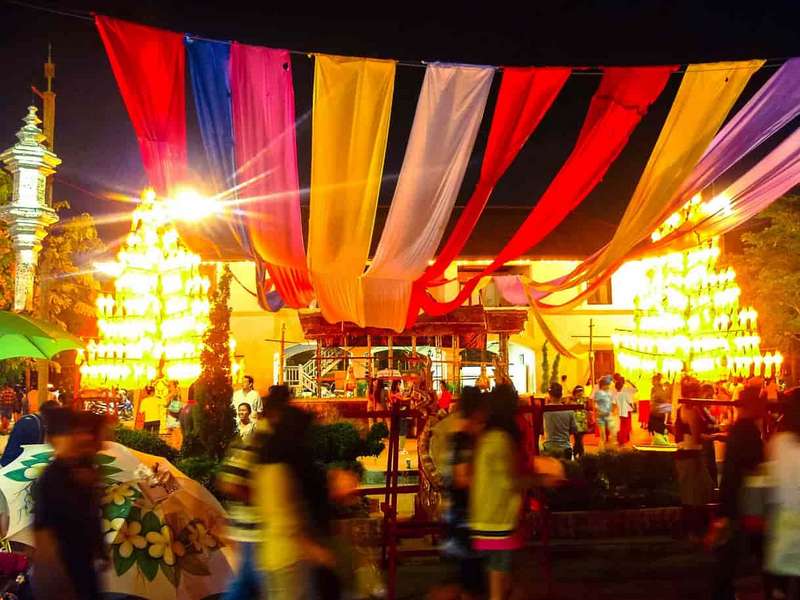 The liveliest attractions in Chiang Rai are the weekend night markets. Much like the ones in Chiang Mai, the large open-air markets can be found with lots of pop-up stalls selling food, clothing, souvenirs, and artworks. You’ll find yourself among a large crowd of tourists here with live music pulsing along in the background. If you can’t decide between the two markets, why not do both? Or go to the Chiang Rai Night Bazaar. The bazaar is open daily from 6 pm to midnight and it is a popular place to hang out at night for good food, cold beer, and live shows. Some nights there is live music, other nights there may be live theatre or Thai comedy shows. You won’t always understand what they’re on about, but its great entertainment. The stalls around the bazaar offer a wide range of handmade goods from the surrounding ethnic villages. You can also find other typical market type goods such as clothing, food, and painting by local artists.
The liveliest attractions in Chiang Rai are the weekend night markets. Much like the ones in Chiang Mai, the large open-air markets can be found with lots of pop-up stalls selling food, clothing, souvenirs, and artworks. You’ll find yourself among a large crowd of tourists here with live music pulsing along in the background. If you can’t decide between the two markets, why not do both? Or go to the Chiang Rai Night Bazaar. The bazaar is open daily from 6 pm to midnight and it is a popular place to hang out at night for good food, cold beer, and live shows. Some nights there is live music, other nights there may be live theatre or Thai comedy shows. You won’t always understand what they’re on about, but its great entertainment. The stalls around the bazaar offer a wide range of handmade goods from the surrounding ethnic villages. You can also find other typical market type goods such as clothing, food, and painting by local artists.
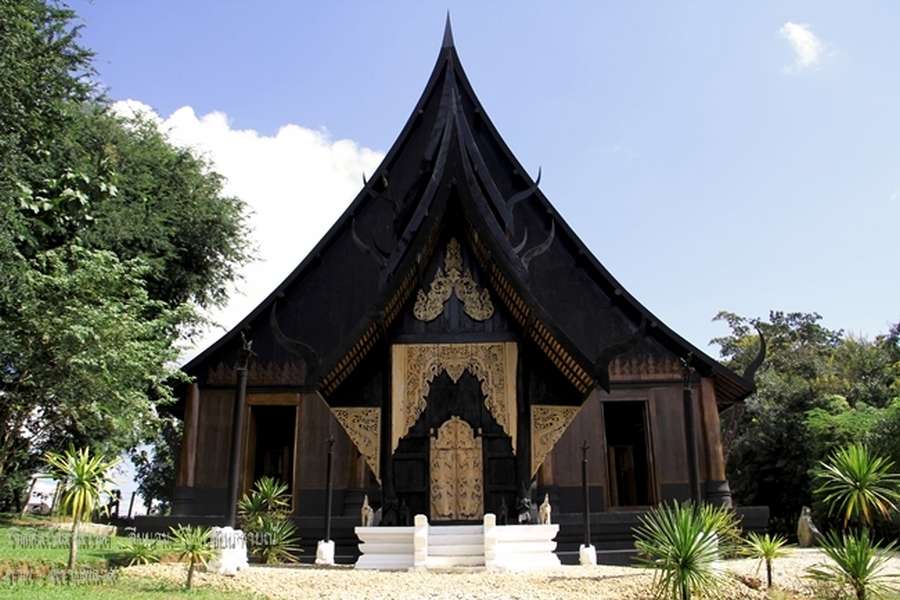 Chiang Rai is considered one of the art capitals of Thailand. There are a multitude of talented artists, their skills ranging from landscape paintings to modern sculptures. Don’t miss out on the Black House (Baan Dam), once the home and studio of the late and renowned artist, Thawan Duchanee, it is now a museum for his work. The Black House is often referred to as the Black Temple and it contrasts sharply with the stunning aesthetic of the White Temple. Be warned, it is not for the faint hearted. The Black Temple consists of 40 unique buildings, mostly designed in traditional yet gothic Thai architecture. Inside lies a bizarre but impressive, intricately carved woodwork, exhibits of animal remains: meticulously displayed skulls and bones, black thrones made of antlers, an entire elephant skeleton and skins hanging from wood beams. The vibe here is dark and, for animal lovers, seemingly sadistic but surprisingly peaceful. There’s serenity to the museum that you won’t find at its often crowded counterpart.
Chiang Rai is considered one of the art capitals of Thailand. There are a multitude of talented artists, their skills ranging from landscape paintings to modern sculptures. Don’t miss out on the Black House (Baan Dam), once the home and studio of the late and renowned artist, Thawan Duchanee, it is now a museum for his work. The Black House is often referred to as the Black Temple and it contrasts sharply with the stunning aesthetic of the White Temple. Be warned, it is not for the faint hearted. The Black Temple consists of 40 unique buildings, mostly designed in traditional yet gothic Thai architecture. Inside lies a bizarre but impressive, intricately carved woodwork, exhibits of animal remains: meticulously displayed skulls and bones, black thrones made of antlers, an entire elephant skeleton and skins hanging from wood beams. The vibe here is dark and, for animal lovers, seemingly sadistic but surprisingly peaceful. There’s serenity to the museum that you won’t find at its often crowded counterpart.
Near the center of town, you’ll find the Chiang Rai clock tower. One of the city’s most distinguished landmarks, the clock tower was designed by the same artist who decorated the famous White Temple. However, if you want to see the clock tower at its best, then you must watch the 10 minute light show which runs every night at 7 pm, 8 pm and 9 pm. The King Mengrai Monument is another popular attraction right near the town center in Chiang Rai, about a 15 minute walk northeast of the clock tower. This monument is dedicated to the founder of the Lanna Kingdom in northern Thailand (the ancient kingdom of Chiang Rai and Chaing Mai) back in 1296. It is a good way to learn a bit about the history of Northern Thailand, and an easy stop if you’re doing a quick walking tour around Chiang Rai.
Going to the beach may sound odd, but it is actually one of the most relaxing things to do in Chiang Rai. Chiang Rai beach is located about 4 km outside of town along the Kok River. It is a great place for a local lunch in one of these bamboo huts surrounded by the forest. You can go for a swim in the river which is a refreshing break. Be careful swimming during the rainy season as the current can get dangerously strong. It is fairly safe to swim or tube down the river in the dry season from October to March.
 Thailand is hot, but in the winter, Chiang Rai is in a place of its own. As the air temperature drops to freezing one of the best things to do in Chiang Rai is to soak away in a natural hot spring. Many of the Chiang Rai hot springs can be difficult to get to, and drivers may even refuse to go to those which are further out but if you have the opportunity to go, don’t hesitate. The Secret Hot Spring is a naturally heated lake set high up in the mountains and a natural infinity pool. If you’d rather not be in a large crowd, there is the Pong Phrabat Hot Spring. Although it is cheap and the closest hot spring to Chiang Rai, don’t expect a scenic setting like the Secret Hot Spring. However, few venture here so you have your privacy. And saving the best for last, the Huay Mak Lium Hot Spring is located along the Kok River in the Lam Nam Kok National Park, about 24 km north-west of Chiang Rai. This is one of the nicest hot springs in Chiang Rai. The hot spring is set in a relaxing forest setting. The water temperature is extremely hot at 65 degrees Celcius, unsuitable for swimming but good for boiling eggs.
Thailand is hot, but in the winter, Chiang Rai is in a place of its own. As the air temperature drops to freezing one of the best things to do in Chiang Rai is to soak away in a natural hot spring. Many of the Chiang Rai hot springs can be difficult to get to, and drivers may even refuse to go to those which are further out but if you have the opportunity to go, don’t hesitate. The Secret Hot Spring is a naturally heated lake set high up in the mountains and a natural infinity pool. If you’d rather not be in a large crowd, there is the Pong Phrabat Hot Spring. Although it is cheap and the closest hot spring to Chiang Rai, don’t expect a scenic setting like the Secret Hot Spring. However, few venture here so you have your privacy. And saving the best for last, the Huay Mak Lium Hot Spring is located along the Kok River in the Lam Nam Kok National Park, about 24 km north-west of Chiang Rai. This is one of the nicest hot springs in Chiang Rai. The hot spring is set in a relaxing forest setting. The water temperature is extremely hot at 65 degrees Celcius, unsuitable for swimming but good for boiling eggs.
Chiang Rai is three hours north of Chiang Mai by bus although you can fly in directly from Bangkok as well. Weather-wise, November to February is the best time to visit the region. It’s the coolest and driest time of the year. The annual Yi Peng festival happens in November every year and it is one of the most festive times to be in the region, the other being Loy Krathong. The rural vibes are soothing and a great place to unwind and relax. Chiang Rai is often overlooked, and tends to be a place used as a stopover for Thailand to Laos or Myanmar. If you take the time to stay here, you will find it has so much more to offer than a city to just breeze through.


